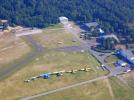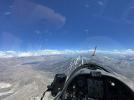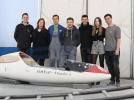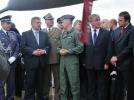Red Wings T204 at Moscow on Dec 29th 2012, overran runway on landing
Russia's MAK released their final report in Russian concluding the probable causes of the accident were:
Misalignment of mechanism and locks of thrust reversers on both engines as well as inappropriate actions (inappropriate provisions in the flight crew operating manual) by the crew during the landing run that resulted in lack of effective braking overrunning the runway and colliding with obstacles at high speed (about 190 kph/102 knots), the destruction of the aircraft and loss of life.
Contributing factors were:
- lack of documentation in what sequence the adjustments and checks of the engine control system should be performed upon replacing the engine control system as well as lack of documentation of rigidity of the controls and thrust reverser locks. This factor only becomes relevant in a handling of the thrust reversers in violation of the flight crew operating manual.
- inconsistencies and contradictions in the maintenance manuals of the aircraft and engines.
- lack of a formal procedure for maintenance organisations engaged in replacing engine management systems (including control mechanism and thrust reverser locks) to provide feedback to the aircraft and engine manufacturer in a timely manner to eliminate defects.
- unstable approach and significant speed exceedance (45 kph/24 knots), that resulted in a prolonged flare, significantly increased landing distance (by about 950 meters), soft touchdown (+1.12G) preventing simultaneous activation of left and right gear compressed signals and thus preventing automatic extension of spoilers and air brakes.
- lack of checks by the crew for extension of spoilers and air brakes
- lack of extending the spoilers manually
- violation of the flight crew operating manual by the crew with respect to the use of reverse thrust, evidenced by the application of maximum reverse thrust in one motion without pause at low reverse thrust and without checking whether the thrust reversers had deployed, which resulted in an increase of (forward) engine thrust.
- absence of a (combined) gear compressed signal (more than 5.5 tons of weight on each main landing gear) throughout the entire landing roll and the crew's failure to extend the spoilers manually resulted in the thrust reversers remaining stowed.
- poor cockpit resource management by the commander throughout the entire flight, which in the approach phase led to lack of monitoring of flight remaining within stabilized approach criteria and the runway overrun
- unsatisfactory organisation of flight operations and non-functional safety management system at the operator, unsatisfactory formal verification of qualification of flight instructors to conduct pilot proficiency verifications, lack of proper monitoring of qualifications and flight operations by objective criteria by the operator made it impossible to identify and eliminate systemic weaknesses in pilot techniques including speed control on landing and use of thrust reversers.
- absence of periodic training of flight crew in reacting to scenarios involving the malfunction of landing gear switches requiring the manual extension of spoilers and speed brakes. The techhnical possibilities at the simulators do not permit to work such scenarios.
The MAK reported that the captain was pilot flying, the first officer was pilot monitoring. The crew determined their landing speed would be 255 kph (137 KIAS), the flight crew operating manual (FCOM) however provided a Vref of 236 kph (127 KIAS). Evident by the flight data recorder there was no buffeting, the computed reference speed thus significantly exceeded the value recommended by the FCOM.
The autopilot and autothrust were disengaged at 60 meters/200 feet AGL, the aircraft crossed the runway threshold at a height of 15 meters (50 feet) and 270 kph (146 KIAS).
The engines were reduced to idle, the aircraft floated for 14-15 seconds down to 4 meters above ground and another 10 seconds until the left main gear showed compressed at about 1.12G at 230 kph (124 KIAS) about 950-1000 meters past the runway threshold, three seconds later the nose gear showed compressed at a bank angle of 1.0 to 1.5 degrees left probably due to crosswind from the right at 11.5 meters/second (22 knots). At the time of the nose gear touchdown the thrust levers were pulled into maximum reverse in one motion and the captain applied manual braking via the brake pedals about 1200-1300 meters past the runway threshold (with about 1860-1760 meters of runway remaining).
As the right hand main gear did not show compressed the thrust reversers did not deploy and the spoilers were not automatically extended. The engines spooled up to about 90% N1 providing forward thrust. The flight engineer called out "No reversers!" Braking was ineffective as only the left main gear had been compressed carrying some weight. The captain released the brakes pedals and the aircraft began to accelerate. About 1300 meters before the end of the runway the bank angle briefly reduced to 0.5 degrees left then increased to 4.4 degrees left bank.
As the airspeed increased the left main gear became unloaded, the bank angle changed to 2.5 degrees right and the right main gear leg showed compressed. After about 8 seconds of maximum reverse thrust the thrust levers were placed into idle reverse, speed was 240 kph at that point, the brakes were applied but again were inefficient, the crew assumed a brakes failure, the engineer demanded "apply reverse!" and the thrust levers were again pulled to maximum reverse thrust at 230 kph and about 650-700 meters of runway remaining. Again, as only the right main gear strut was compressed the thrust reversers remained stowed and the engines accelerated to 84% N1 providing forward thrust. The first officer joined in attempts to apply brakes to increase brakes pressure. The thrust levers were again placed into idle reverse, the aircraft crossed the runway end, someone in the cockpit demanded "turn engines off", the fire handles of both engines were pulled at 215 kph about 200 meters past the runway end, while running over rough terrain both gear struts compressed simultaneously, the thrust reversers and spoilers went into their deployed positions but the aircraft collided with a slope of a ravine at about 180-190 kph over ground.
The MAK reported that the limit switches indicating the gear strut had been compressed had also failed in a runway overrun, see Incident: Red Wings T204 at Novosibirsk on Dec 20th 2012, runway excursion on landing, as well as an incident without consequences, see Incident: Red Wings T204 at Moscow on Dec 29th 2012, thrust reverser did not correctly open on landing. The MAK thus analysed that within a period of 10 days four (editorial note: ???) cases of failure of compressed signals for various reasons on two aircraft (RA-64047, RA-64049) have been recorded.
The failures of the switches have been analysed, Tupolev is going to change the logic of air/ground determination.
The MAK analysed that to appy reverse thrust the thrust levers need to be pulled to idle thrust first, then a force of about 2.8kg +/- 0.3 lg, not more than 4kg, needs to be applied to pull the thrust levers into idle reverse. About 2-3 seconds later the thrust reversers would normally have moved into their deployed position. However, to prevent the engines going into reverse while airborne a hydraulic lock prevents the thrust reversers to enter the deployed position if the aircraft is determined airborne (not both main gear legs compressed, at least one of two limit switches on each leg being closed).
The engine has been designed to not permit engine acceleration with the thrust levers at or aft of idle reverse and thrust reversers not in their deployed position.
The MAK analysed, that this locking mechanism had failed permitting the engines to accelerate despite thrust levers in reverse position and thrust reversers still stowed. The locking mechanism consists of a mechanical system, that requires a rigid adjustment permitting a total backlash of the system of not more than 0.7mm.
During tests it was shown however that when a force of about 15kg was applied on the thrust lever, a displacement could take place due to deformation and displacement of a number of structural elements, compromising the required rigidity of the engine thrust lock.
Following the accident a number of elements were added to the mechanism to reinforce the rigidity of the system.
RA-64047 before the highway embankment (Photo: MAK):
http://avherald.com/h?article=45b4b3cb/0003














Komentarze